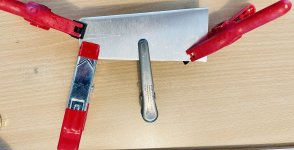Wolfgang_UK
Staff Sergeant
- Joined
- Dec 5, 2009
- Messages
- 836
Hi,
thank you very much for this detailed and interesting answer. Yes you are totally right with your historic assumptions on the history of those planes.
On many period photographs one gets easily confused about which engine was used on the plane. Anyway this and the HECO thread had led me to
join the ranks of the tin plate enthusiasts. I have been a follower of Heyde figures of Dresden for a very long time and I allways felt like adding figurines
- not replicas but addition to this fantastic range of figurines. The Baron left the contact details for the Heyde Archiv here at the forum, you got to register
but that page surely is fantastic.
So I started with tin-plate and snips to create my own WWI fighter plane. Had the brilliant idea to use the same plan for building three planes at the same time.
The idea is to get-one-through, easier said than done but tinplate is a fantastic material and great fun to work with. I constructed a bending tool and did bend the wings today - worked amost perfect. Oberursel engines are done so are the rudders and parts of the fuselage and landing gear. Hope to get progressing forward, but I started a civil (anno 1900) beach scene with boats and a lot of other stuff as well. When done I might open a thread on it.
Hope to see more of your work in due time
Take care
Wolfgang
thank you very much for this detailed and interesting answer. Yes you are totally right with your historic assumptions on the history of those planes.
On many period photographs one gets easily confused about which engine was used on the plane. Anyway this and the HECO thread had led me to
join the ranks of the tin plate enthusiasts. I have been a follower of Heyde figures of Dresden for a very long time and I allways felt like adding figurines
- not replicas but addition to this fantastic range of figurines. The Baron left the contact details for the Heyde Archiv here at the forum, you got to register
but that page surely is fantastic.
So I started with tin-plate and snips to create my own WWI fighter plane. Had the brilliant idea to use the same plan for building three planes at the same time.
The idea is to get-one-through, easier said than done but tinplate is a fantastic material and great fun to work with. I constructed a bending tool and did bend the wings today - worked amost perfect. Oberursel engines are done so are the rudders and parts of the fuselage and landing gear. Hope to get progressing forward, but I started a civil (anno 1900) beach scene with boats and a lot of other stuff as well. When done I might open a thread on it.
Hope to see more of your work in due time
Take care
Wolfgang









